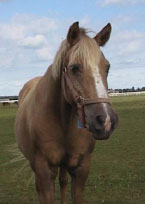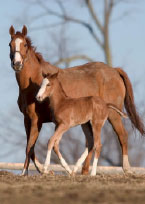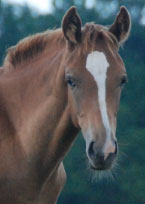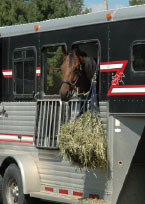Vaccine Guidelines – By Horse

Adult Horses (Risk Factor: Geographic Location)
Horses maintained on rural properties with little or no contact with other horses have minimal risk of coming in contact with these agents. However, if they do, they often exhibit severe signs of disease since their immune systems are relatively naïve (little or no immunity). It is recommended that horses exposed to minimal risk are vaccinated with the basic or core vaccines. It is also important to recognize that different disease agents have different geographic distributions. This can be related to;
• The ecology of the vector, e.g., Culiseta melanura, the mosquito vector of EEE, seems to be confined to some swamps and is probably related to the migration of birds from infected areas in the Southern USA to the same general summer ranges.
• It is important to recognize that disease agents can have different geographic distributions. Often this can be related to the ecology of the disease vector such as mosquitoes or wildlife. For example:
- Potomac horse fever is generally reported from Eastern Ontario. This may be related to the complex aquatic ecosystem associated with the insect vectors (caddisflies, damselflies, dragonflies, and stoneflies). Horse owners report very large hatches of these insects at certain times of the year in these areas.
- In Canada, Eastern equine encephalitis has only been diagnosed in Ontario and Quebec (as of 2022).

Broodmares (Risk Factor: Pregnancy)
Pregnant mares are at risk of being affected by infectious agents such as bacteria and viruses. The agent can either kill the fetus in the uterus directly or cause physiologic changes in the mare which can result in abortion. The emotional and financial losses are significant, and welfare of the mare is compromised.
Some infectious agents, such as equine herpesvirus-1, can lay dormant (latent) in horses until the latter are stressed by circumstances such as shipping. The virus becomes active again and is shed from the nose. Other mares can become exposed to the virus through nose-to-nose contact and the subsequent infection can lead to a single abortion or abortion storms when a number of mares abort. The aborted fetus, placenta and placental fluids contain a large amount of virus putting other mares that are in contact with them at risk for infection. Biosecurity is extremely important when managing these disease situations; vaccination is just one aspect.

Foals (Risk Factor: Age)
Protective antibodies and other factors ingested from the mare’s colostrum (passive immunity) protects the foal during the first 9-12 weeks of age. Foals begin to produce their own antibodies (active immunity) immediately after birth when they are first exposed to antigens, however, these antibodies don’t reach a protective concentration until the foal is two months of age or older.
To maximize the amount and type of antibodies in the mare’s colostrum in order to protect the foal, mares should be vaccinated 4-6 weeks prior to foaling. The foal is then vaccinated at 6 months of age when the antibodies passed on from the mare are waning and less likely to interfere with the foal’s ability to produce antibodies to vaccines.
Foals from non-vaccinated mares should receive their first vaccination between 3 and 4 months of age; the second between 4 and 5 months of age; a third between 5 and 6 months of age.
- Foals from vaccinated mares should receive should receive certain first vaccinations at 4-6 months followed by a 2nd dose 4-6 weeks later and a 3rd dose at 10-12 months of age
- Foals vaccinated with the West Nile virus Flavivirus vaccine only require one vaccination at 5-6 months of age followed by a booster at 10-12 months of age prior to the next mosquito season

Traveling Horses (Risk Factor: In and Out Traffic)
When there are horses that come and go from a facility, there is an increased risk of exposure to viral and bacterial pathogens not only for those horses leaving the property and mingling with other horses at shows, competitions etc. but also for the resident horses. Of main concern are the contagious respiratory pathogens such as influenza, EHV-1/4, Strangles and equine rhinitis virus A. Both competition horses and resident horses, if exposed to the competition horses, should be vaccinated for influenza and EHV-1/4 and also Strangles if it’s a risk in the appropriate discipline. There is no vaccine presently in Canada for equine rhinitis virus A but, for the other diseases, please see the information under risk-based vaccines.
To learn more about how to decrease the risk of spreading diseases when traveling, check out Equine Guelph’s Biosecurity Risk Calculator!
Please note: This information provides guidelines only and should never replace information from your veterinarian.
References:
For more information, contact
Guidelines for The Vaccination of Horses. Lexington; AAEP, 2008
OMAFRA
Toll Free: 1-877-424-1300
Local: (519) 826-4047
E-mail: [email protected]






